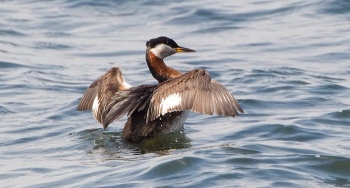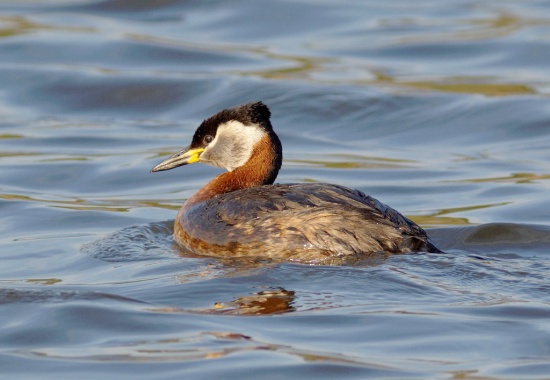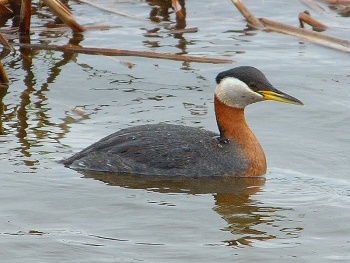Nutcracker (talk | contribs) m (format) |
Nutcracker (talk | contribs) m (typo) |
||
| Line 38: | Line 38: | ||
==Taxonomy== | ==Taxonomy== | ||
====Subspecies==== | ====Subspecies==== | ||
| − | There are | + | There are two subspecies<sup>[[#References|[1]]]</sup>: |
[[Image:Red-necked_Grebe.jpg|thumb|350px|right|''P. g. holbollii'', summer plumage<br />Photo by {{user|DaveMC|DaveMC}}<br/>[[Big Lake (Alberta)|Big Lake]], [[Alberta]].]] | [[Image:Red-necked_Grebe.jpg|thumb|350px|right|''P. g. holbollii'', summer plumage<br />Photo by {{user|DaveMC|DaveMC}}<br/>[[Big Lake (Alberta)|Big Lake]], [[Alberta]].]] | ||
*''P. g. grisegena'': western Eurasia | *''P. g. grisegena'': western Eurasia | ||
Revision as of 17:24, 29 September 2016
- Podiceps grisegena
Identification
A medium-large grebe; length 40-50 cm, wingspan 77-85 cm, weight 800-925 g
Breeding plumage
- Dark grey-brown above
- Chestnut sides and front of neck
- Breast-sides and flanks chestnut mottled brown
- Black crown and small crest
- Cheeks white to grey, bordered with white
- Hindneck dark brown
- Dark brown iris
- Black bill with bright yellow base (extent of yellow very variable, from a small spot, to nearly all-yellow)
- Blackish to olive legs
- In flight, secondaries and lesser secondary coverts white, but scapulars blackish
Winter plumage
- Neck dusky grey
- Flanks paler and greyer
Juvenile plumage
- Neck pale rusty-red
- Cheeks with dark bands
Similar species
- Great Crested Grebe is often confused in winter plumage; differs in whiter flanks, neck and face, longer neck, pink bill, and in flight, white scapulars as well as secondaries and lesser secondary coverts.
- Slavonian / Horned Grebe is smaller, with pure white cheeks and neck in winter plumage.
Distribution
A widespread species in the Northern Hemisphere.
The nominate subspecies P. g. grisegena breeds in Europe and western Asia from Denmark and Germany eastwards, ranging north to central Finland and south to the Black Sea; has also bred irregularly in Britain and elsewhere in western Europe. Breeds in scattered populations in Turkey and east to central Asia. The main wintering range lies in the Baltic, from southern Norway to Biscay including Britain, and in the Caspian Sea with smaller numbers in the northern Mediterranean and Black Seas, and rarely south to north Africa.
The subspecies P. g. holbollii breeds in North America in Alaska and much of western and central Canada east to Ontario and in the northern USA in Washington, Montana, North Dakota, northern South Dakota and Minnesota; it has also bred in Quebec and New Hampshire. It also breeds in northeast Asia in northeastern China, the Russian far east (including Sakhalin and Kamchatka), and Hokkaido, Japan. American birds winter on both coasts, in the west from the Aleutians south to northern California, rarely further south, and in the east from Nova Scotia south to Long Island, rarely north to Newfoundland and south to Florida. East Asian birds winter from Sakhalin and Honshu south to East China Sea and a vagrant to Hong Kong.
Migratory and dispersive. The North American subspecies has occurred as a vagrant in Europe.
Taxonomy
Subspecies
There are two subspecies[1]:
- P. g. grisegena: western Eurasia
- Smaller, with a weaker bill; diet mainly aquatic invertebrates and small fish[2]
- P. g. holbollii (syn. P. g. holboellii, a spelling error): North America and northeast Asia
- Larger, with a heavier bill; diet mainly fish[2]
Habitat
Small-medium, well-vegetated freshwaters.
Behaviour
Breeding
It builds a nest of a heap of rotting vegetation, floating and attached to plants or built on the bottom in shallow water. 4-5 eggs, white initially, soon becoming stained, are laid and incubated by both sexes for 22-25 days. Young tended by both sexes for 56-70 days. Single-brooded.

Photo by targetman.
Lincolnshire coast, UK, July 2011
Diet
Includes aquatic invertebrates and small fish taken in dives around 30 seconds long.
Vocalisation
Vocal during breeding season uttering a variety of wailing, howling and roaring sounds. Silent in winter.
<flashmp3>Podiceps grisegena (song).mp3</flashmp3>
Listen in an external program
References
- Clements, J. F., T. S. Schulenberg, M. J. Iliff, D. Roberson, T. A. Fredericks, B. L. Sullivan, and C. L. Wood. 2016. The eBird/Clements checklist of birds of the world: v2016, with updates to August 2016. Downloaded from http://www.birds.cornell.edu/clementschecklist/download/
- Del Hoyo, J, A Elliot, and J Sargatal, eds. 1992. Handbook of the Birds of the World. Volume 1: Ostrich to Ducks. Barcelona: Lynx Edicions. ISBN 978-8487334108
Recommended Citation
- BirdForum Opus contributors. (2024) Red-necked Grebe. In: BirdForum, the forum for wild birds and birding. Retrieved 5 May 2024 from https://www.birdforum.net/opus/Red-necked_Grebe
External Links







